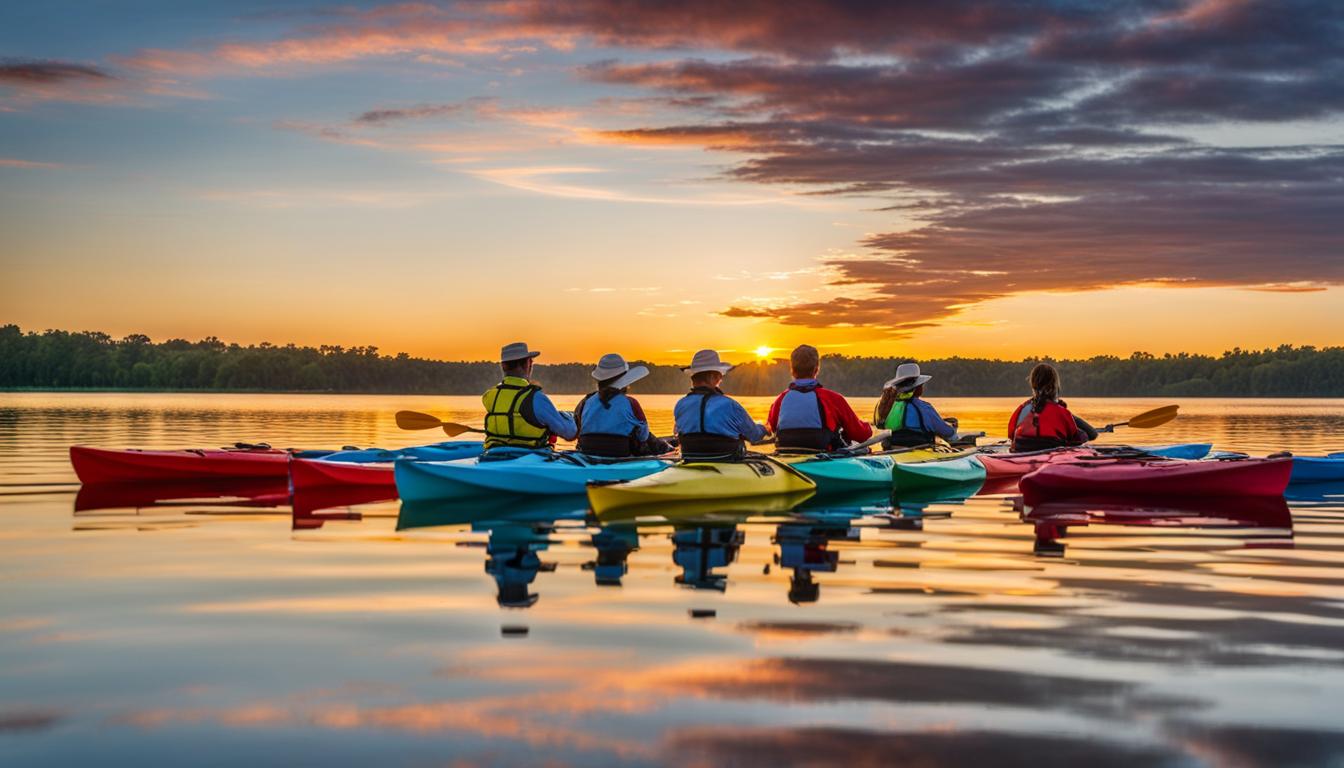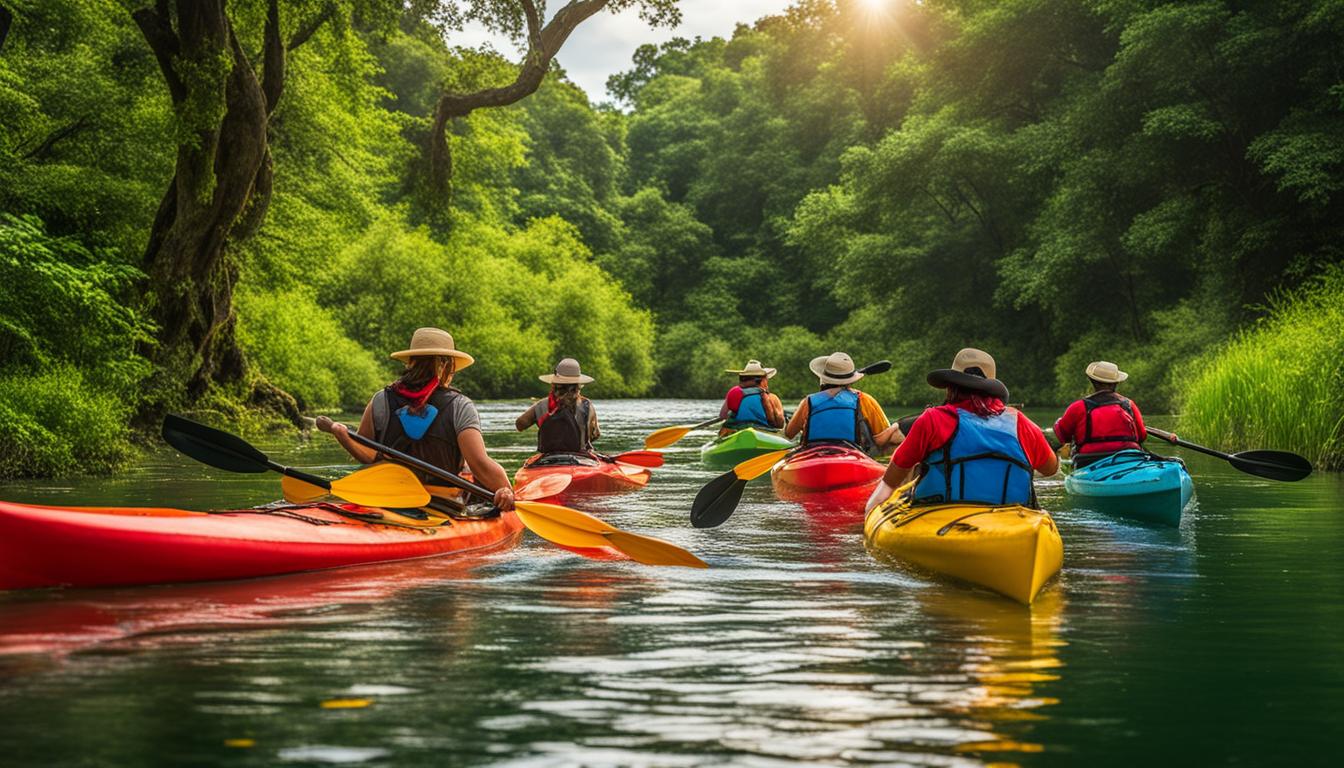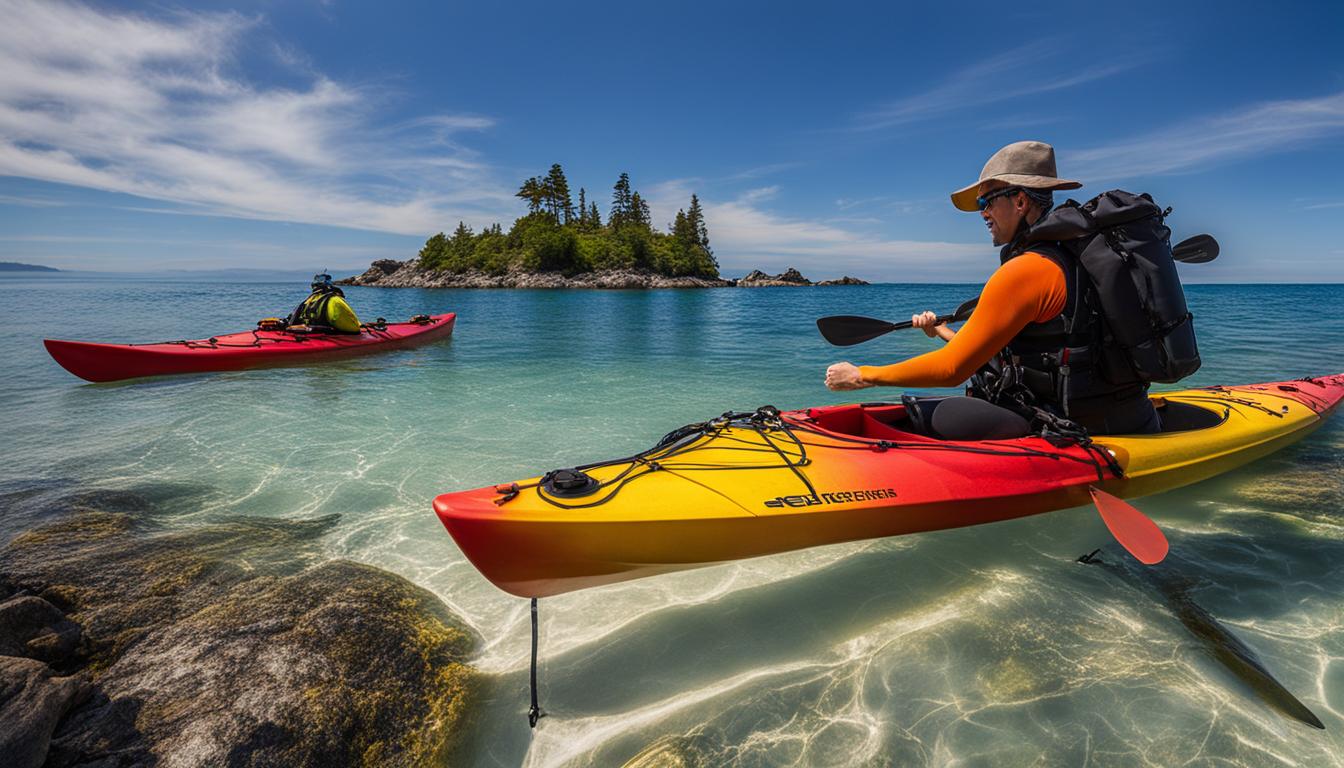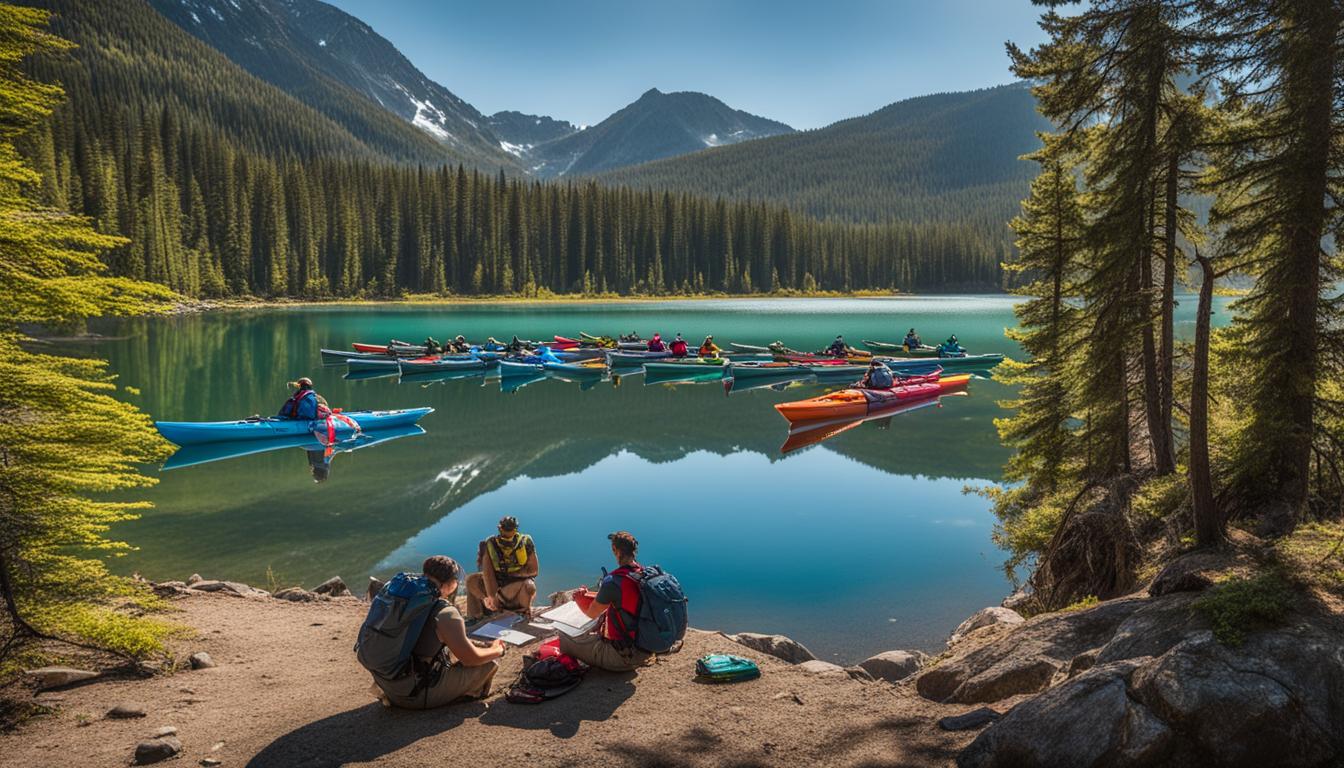Kayak camping allows you to explore remote and inaccessible places while enjoying the serenity of nature. It offers several benefits, such as the ability to access narrow and shallow waters that larger boats cannot reach. Kayak camping is also a great stress reliever and a challenging adventure for experienced kayakers. It is a family-friendly activity that allows for quality bonding time. Before heading out on a kayak camping trip, it is essential to plan your trip, check the weather, determine your kayak’s load capacity, distribute the weight of your gear, and ensure your kayak is in good working order.
Key Takeaways:
- Choose a kayak campsite based on accessibility and proximity to water.
- Consider the terrain, weather conditions, and local regulations when selecting a campsite.
- Plan your kayak camping trip in advance and inform someone about your route and campsite location.
- Pack lightweight, compact, and weather-appropriate gear for your kayak camping adventure.
- Enjoy the beauty of nature and the unique experiences that kayak camping offers.
Benefits of Kayak Camping
Kayak camping offers a multitude of advantages and benefits that make it an appealing activity for outdoor enthusiasts. One of the primary benefits is the ability to explore remote and inaccessible places that are not easily reached by foot or larger boats. With a kayak, you can navigate through narrow waterways, shallow rivers, and hidden coves, giving you access to untouched natural landscapes.
Aside from the thrill of exploration, kayak camping also provides an opportunity for adventure and relaxation. As you paddle along the water, you can truly go with the flow, allowing the current to guide you to new and exciting destinations. The combination of kayaking and camping creates a unique experience, allowing you to immerse yourself in nature while enjoying the freedom and flexibility of traveling by kayak.
Another benefit of kayak camping is its ability to relieve stress and promote mental well-being. Spending time in nature has been proven to reduce stress levels and improve overall mood. Kayaking itself is a great way to unwind and connect with the serenity of the water, and when combined with camping, it creates a holistic and rejuvenating experience.
“Kayak camping offers a range of benefits, including the ability to explore remote and inaccessible places.”
Lastly, kayak camping is a versatile activity that can be enjoyed by individuals of all ages. It is a family-friendly adventure that encourages bonding and creates lasting memories. Whether you’re an experienced kayaker looking for a challenging expedition or a beginner seeking a unique outdoor experience, kayak camping offers something for everyone.
Overall, the benefits of kayak camping are vast and encompass the joy of exploration, the thrill of adventure, the tranquility of nature, and the opportunity for quality time with loved ones. It is a truly immersive and rewarding activity that allows you to discover remote places and create unforgettable experiences.

Planning Your Kayak Camping Trip
Kayak camping trips require careful planning to ensure a safe and enjoyable experience. Whether you’re a beginner or an experienced kayaker, these tips will help you prepare for your adventure.
1. Choose the Right Route
When planning your kayak camping trip, consider selecting a route that suits your skill level and experience. If it’s your first time, opt for a shorter route with calm waters to build confidence. Research the area and consult local guides or online resources for recommendations on scenic and safe routes that are suitable for kayaking.
2. Inform Someone of Your Itinerary
Prior to embarking on your kayak camping trip, inform a reliable friend, family member, or park ranger about your paddling route and campsite location. This step is essential for safety purposes in case of unforeseen circumstances or emergencies. Provide them with detailed information about your intended departure and return dates, expected stops, and any alternative plans.
3. Check the Weather
Always check the weather forecast before heading out on your kayak camping trip. Unfavorable weather conditions can significantly impact your safety and overall experience. Look for local weather reports and pay attention to wind speed, rain chances, and temperature fluctuations. Adjust your plans accordingly and consider rescheduling if the conditions are not suitable.
4. Pack Your Gear Wisely
Proper gear selection and packing are crucial for a successful kayak camping trip. Start by determining your kayak’s load capacity and distributing the weight of your gear evenly. Use dry bags to store your belongings and protect them from water damage. Create a checklist to ensure you have all the essential items, including food, water, camping equipment, navigation tools, safety gear, and personal items.
| Essential Gear for Kayak Camping | Additional Considerations |
|---|---|
| – Waterproof or quick-drying clothing | – Extra paddle and kayak repair kit |
| – Sunscreen and insect repellent | – Portable water filter or purification tablets |
| – Navigation tools (compass, maps, GPS) | – Emergency signaling devices (whistle, mirror) |
| – First aid kit | – Binoculars for wildlife observation |
Remember to pack light and prioritize essential items. Avoid bulky or unnecessary gear that may take up valuable space in your kayak.
By following these tips, you’ll be well-prepared for your kayak camping trip and ready to make lasting memories in the great outdoors. Enjoy the beauty of nature and the unique experiences that kayak camping has to offer!

Selecting the Right Kayak Camping Gear
When it comes to kayak camping, selecting the right gear is essential for a successful and enjoyable trip. The gear you choose should be lightweight, compact, and weather-appropriate. Here are some essential items to consider for your kayak camping adventure:
Gear Checklist for Kayak Camping
| Item | Description |
|---|---|
| Dry Bags | Use dry bags to store your clothing, food, and other items. They will keep your belongings dry even if your kayak capsizes. |
| Personal Flotation Device (PFD) | Always wear a PFD while kayaking to ensure your safety. Choose a PFD that is comfortable and provides proper buoyancy. |
| Repair Kit | Bring a repair kit for your kayak in case of any mishaps or damages. It should include items like duct tape, a patch kit, and a multi-tool. |
| Towel | Carry a quick-dry towel to dry off after kayaking or swimming. It should be lightweight and absorbent. |
| Binoculars | Binoculars are handy for observing wildlife and enjoying the surrounding nature. Choose a lightweight and compact pair. |
| Camping Stove with Fuel | A camping stove will allow you to cook meals while camping. Ensure you have enough fuel for the duration of your trip. |
| Tent or Hammock | Decide whether you prefer a tent or a hammock for sleeping. Both have their advantages, so choose the option that suits your comfort and preferences. |
| Sleeping Bag and Pad | Bring a sleeping bag and pad for a comfortable night’s sleep. Choose ones that are lightweight, compact, and suitable for the expected weather conditions. |
| Headlamp | A headlamp is essential for hands-free lighting during the night. Opt for a lightweight and adjustable headlamp. |
| Small Daypack | A small daypack is useful for exploring on land during your kayak camping trip. It should be lightweight and have enough space for essentials. |
Remember to pack these items based on the length and duration of your trip, as well as the weather conditions you anticipate. Prioritize lightweight and compact gear to save space in your kayak and make paddling easier. With the right gear, you’ll be well-equipped for a fantastic kayak camping experience.
Conclusion
As you reach the end of this article, it is clear that selecting the right campsite for your kayak camping adventure is of utmost importance. It not only allows you to immerse yourself in the beauty of nature but also enables you to explore remote and undiscovered places that are beyond the reach of larger boats or on foot.
By following the tips and guidelines provided throughout this article, you can ensure a safe and enjoyable kayak camping experience. Remember to plan your trip meticulously, checking the weather conditions and preparing the necessary gear. Make sure to distribute the weight evenly in your kayak and choose a suitable campsite that offers both comfort and stunning views.
Whether you are an experienced kayaker seeking a thrilling challenge or a family looking for a bonding adventure, kayak camping provides a unique opportunity to connect with nature and create lasting memories. So, pack your gear, embark on your journey, and let the serenity of the water guide you to the perfect campsite. Happy kayaking and camping!
FAQ
Can I kayak camp in any body of water?
You can kayak camp in lakes, rivers, and coastal areas. However, it is essential to check local regulations and obtain any necessary permits before camping in specific locations.
How do I find kayak accessible campsites?
Research online for kayak accessible campsites in your desired area. Many campgrounds and parks have designated kayak camping areas or allow kayakers to camp along the shoreline. You can also ask local kayak rental companies or experienced kayakers for recommendations.
How should I select a kayak campsite?
When selecting a campsite, look for a location that offers a flat and level area to set up your tent or hammock. Consider proximity to water access, such as a beach or a calm section of the river, and choose a spot that provides privacy and scenic views. Avoid camping in fragile ecosystems or protected areas.
What should I do if the weather changes during my kayak camping trip?
It is important to check the weather before your trip and pack accordingly. However, if the weather changes unexpectedly, seek shelter and wait for conditions to improve. Make sure you have proper rain gear and a tarp or a tent to protect yourself from rain or wind.
How can I ensure a safe kayak camping experience?
Prioritize safety by wearing a personal flotation device (PFD) at all times on the water and following basic boating safety guidelines. Inform someone reliable about your paddling route and campsite location. Familiarize yourself with kayak rescue techniques and always paddle within your skill level.





